Figure 8.
BiFC experiments showing that CrSGD fused either in N-terminus or C-terminus of YFP fragments are able to specifically interact. To evaluate the BiFC, undifferentiated C. roseus cells were co-transformed with the construct indicated on the left (fusions with the YFPC fragment) and the construct indicated on the top (fusions with the YFPN fragment). Interactions between two CrSGD fusions allowed reconstitution of the YFP fluorochrome with a diffuse nuclear fluorescence pattern when at least one of the C-terminus was blocked by a YFP fragment (e, f, h), whereas an aggregated fluorescence pattern required the interaction of two fusion proteins with an accessible CrSGD C-terminal extremity. bZIP63 was used as a positive control of BiFC and to test for non-specific interaction with CrSGD fusions. The efficiency of the co-transformation was further evaluated with the co-transformation of a "plastid"-CFP marker (Additional file 4). The images presented are merges of the YFP BiFC channel (Magenta false colour) and DIC channel to show the morphology of the cells. YFPN, (aa 1-173); YFPC, (aa 156-239). Bar: 10 μm.

